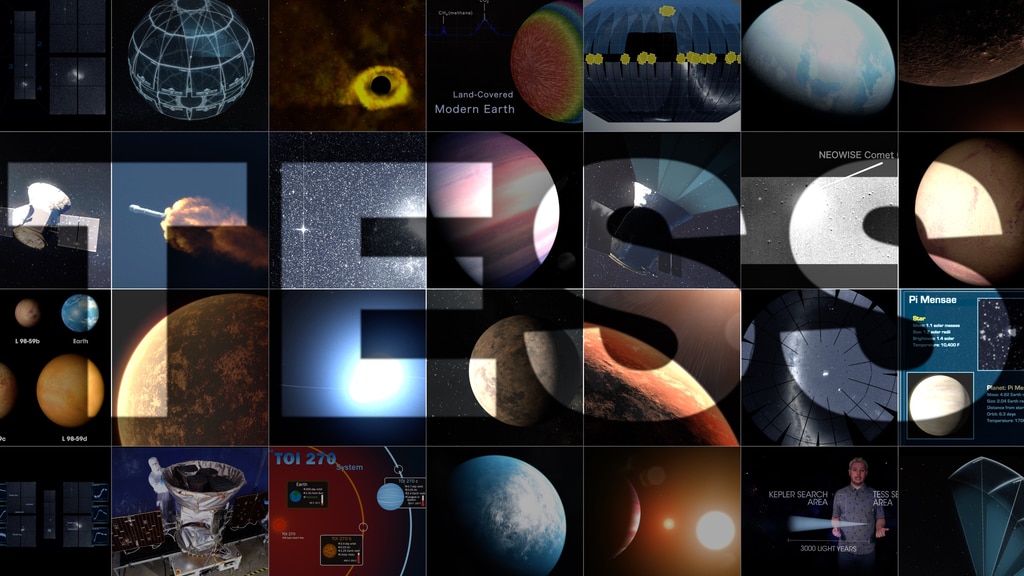TESS Satellite Discovered Its First World Orbiting Two Stars
NASA’s Transiting Exoplanet Survey Satellite found its first circumbinary planet, a world orbiting two stars 1,300 light-years away. Watch to learn more about this Saturn-size world called TOI 1338 b.
Credit: NASA's Goddard Space Flight Center
Music: "Albatross" from Universal Production Music.
Complete transcript available.
Watch this video on the NASA Goddard YouTube channel.
Researchers working with data from NASA’s Transiting Exoplanet Survey Satellite (TESS) have discovered the mission’s first circumbinary planet, a world orbiting two stars. The planet, called TOI 1338 b, is around 6.9 times larger than Earth, or between the sizes of Neptune and Saturn. It lies in a system 1,300 light-years away in the constellation Pictor.
The stars in the system make an eclipsing binary, which occurs when the stellar companions circle each other in our plane of view. One is about 10% more massive than our Sun, while the other is cooler, dimmer and only one-third the Sun’s mass.
TOI 1338 b’s transits are irregular, between every 93 and 95 days, and vary in depth and duration thanks to the orbital motion of its stars. TESS only sees the transits crossing the larger star — the transits of the smaller star are too faint to detect. Although the planet transits irregularly, its orbit is stable for at least the next 10 million years. The orbit’s angle to us, however, changes enough that the planet transit will cease after November 2023 and resume eight years later.
The stars in the TOI 1338 system make an eclipsing binary — they circle each other in our plane of view. If you could hover near the planet TOI 1338 b, as shown in this animation, you would see an eclipse every 15 days.
Credit: NASA's Goddard Space Flight Center/Chris Smith (USRA)
TOI 1338 b is the only known planet in this binary star system. It’s around 6.9 times Earth’s size, or between the sizes of Neptune and Saturn. It is likely a gaseous world, as shown in this animation.
Credit: NASA's Goddard Space Flight Center/Chris Smith (USRA)
This animation shows TOI 1338 b as it passes, or transits, in front of its stars. TESS can only detect the transits from the larger star, the transits of the smaller star are too faint to detect. Simulated data shown at the bottom of the animation illustrates how the signal from the planet’s transit looks similar to the eclipse of the large star by its companion.
Credit: NASA's Goddard Space Flight Center/Chris Smith (USRA)
TOI 1338 b’s transits are irregular, between every 93 and 95 days, and vary in depth and duration thanks to the orbital motion of its stars. This animation shows how the angle of the planet’s orbit changes over time.
Credit: NASA's Goddard Space Flight Center/Chris Smith (USRA)
Take a 360-degree tour around this illustration of TOI 1338 b. A 4K still image is also available.
Credit: NASA's Goddard Space Flight Center/Chris Smith (USRA)
Credits
Please give credit for this item to:
NASA's Goddard Space Flight Center
-
Producer
- Chris Smith (USRA)
-
Animator
- Chris Smith (USRA)
-
Science writers
- Jeanette Kazmierczak (University of Maryland College Park)
- Francis Reddy (University of Maryland College Park)
-
Writer
- Chris Smith (USRA)
-
Scientist
- Veselin Kostov (NASA Postdoctoral Fellow)
Missions
This page is related to the following missions:Series
This page can be found in the following series:Release date
This page was originally published on Monday, January 6, 2020.
This page was last updated on Wednesday, May 3, 2023 at 1:45 PM EDT.
